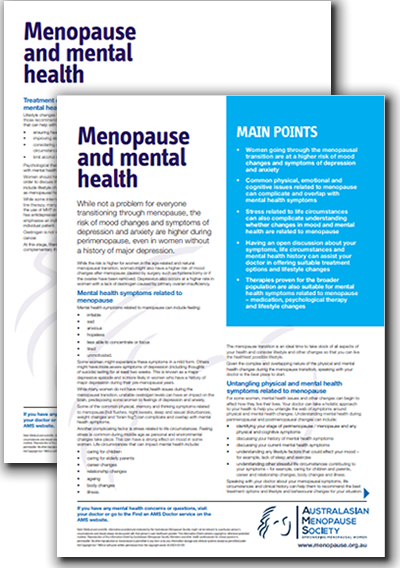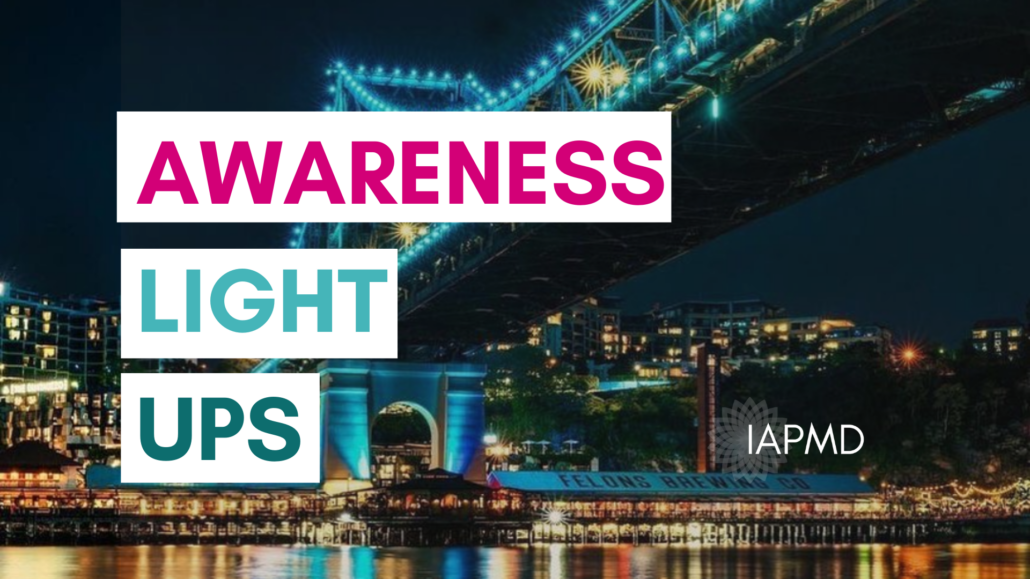“You may experience physical and emotional symptoms
about one week before your period.
This is called ‘premenstrual syndrome’ or ‘PMS’”.1
Umbrella
What may the Premenstrual Syndrome Umbrella include?
Depending on the Source (DotS) this Umbrella may include:
- Premenstrual Dysphoric Disorder (PMDD)
- Premenstrual Mood Changes
- Premenstrual Syndrome (PMS)
- Premenstrual Tension (PMT)
Premenstrual Syndrome
What is premenstrual syndrome (PMS)?
DotS the definition of PMS may vary. The American College of Obstetricians and Gynecologist’s (ACOG) definition is:
“Many women feel physical or mood changes during the days before menstruation. When these symptoms happen month after month, and they affect a woman’s normal life, they are known as premenstrual syndrome (PMS)”.2
The (Australian) Jean Hailes for Women’s Health’s (JH) definition is:
“You may experience physical and emotional symptoms about one week before your period. This is called ‘premenstrual syndrome’ or ‘PMS’”.3
The (United States) Medline Plus’s definition is:
“Premenstrual syndrome, or PMS, is a group of physical and emotional symptoms that start one to two weeks before your period. Most women have at least some symptoms of PMS, and the symptoms go away after their periods start. The symptoms may range from mild to severe”.4
PMS Symptoms
What are some PMS symptoms?
In Premenstrual Syndrome (PMS): Symptoms & Causes – Symptoms the (United States) Mayo Clinic reassure:
“The list of potential signs and symptoms for premenstrual syndrome is long, but most women only experience a few of these problems”.5
In Premenstrual Syndrome (PMS): What Are the Symptoms of PMS? the JH also note:
PMS Emotional Symptoms
What are PMS emotional symptoms?
In Premenstrual Syndrome (PMS): What Are the Symptoms of PMS? Emotional Symptoms the JH elaborate on:
- Irritability
- Anxiety
- Lower ability to cope
- Difficulty concentrating
- Mood changes
- Sadness”.7
In FAQs: Premenstrual Syndrome (PMS): What Are Some Common Symptoms of PMS? ACOG elaborate on:
- Depression
- Angry outbursts
- Irritability
- Crying spells
- Anxiety
- Confusion
- Social withdrawal
- Poor concentration
- Insomnia
- Increased nap taking
- Changes in sexual desire”.8
PMS Physical Symptoms
What are PMS physical symptoms?
In Premenstrual Syndrome (PMS): What Are the Symptoms of PMS? Physical Symptoms the JH elaborate on:
- Cramping in the pelvic area
- Bloating around the belly (abdomen)
- Breast swelling and tenderness
- Fluid retention (swollen fingers or ankles)
- Skin problems such as acne
You may also experience:
- Headaches
- Tiredness, lethargy, insomnia
- Constipation, diarrhea or both
- Food cravings
- Aches and pains”.9
In FAQs: Premenstrual Syndrome (PMS): What Are Some Common Symptoms of PMS? ACOG elaborate on:
- Thirst and appetite changes (food cravings)
- Breast tenderness
- Bloating and weight gain
- Headache
- Swelling of the hands or feet
- Aches and pains
- Fatigue
- Skin problems
- Gastrointestinal symptoms
- Abdominal pain”.10
PMS Cause
What causes PMS?
The JH explain:
“It’s not clear why some people have PMS. It may be associated with the hormone progesterone interacting with certain chemicals in the brain. Other factors can influence symptoms, including stress levels, physical and emotional health and lifestyle”.11
Different Differences
Is PMS different to premenstrual dysphoric disorder (PMDD)?
In Premenstrual Syndrome (PMS): What Is PMS? the JH note:
In Premenstrual Dysphoric Disorder (PMDD) the JH also note:
Premenstrual Dysphoric Disorder
What is premenstrual dysphoric disorder (PMDD)?
DotS the definition of PMDD may vary. In Learn: PMDD the International Association For Premenstrual Disorders (IAPMD) definition is:
Premenstrual Exacerbation
What is premenstrual exacerbation (PME)?
DotS the definition of PME may vary. In Learn: PME the IAPMD’s definition is:
Premenstrual Dysphoric Disorder (PMDD) and Premenstrual Exacerbation (PME) are difficult to distinguish from each other”.15
PMDD Cause
What causes PMDD?
In Premenstrual Syndrome and Premenstrual Dysphoric Disorder: Diagnosis and Prevention the (United States) Endocrine Society note:
Predictable Pattern
Do PMS symptoms tend to recur in a predictable pattern?
Yes. The Mayo Clinic explain:
“Symptoms tend to recur in a predictable pattern. But the physical and emotional changes you experience with premenstrual syndrome may vary from just slightly noticeable all the way to intense”.17
Look for A Pattern
How may I Look for A Pattern with PMS?
In Tracking Your Cycle & Symptoms the IAPMD explain:
In Menstrual Diary the (United Kingdom) National Association for Premenstrual Syndrome explain:
“A completed menstrual chart is the first step towards understanding your own menstrual health”.19
In Premenstrual Syndrome (PMS): What To Expect the (Scottish) NHS Inform also note:
Menstrual Diary
![]() Where may I find a menstrual diary to keep a record of any symptoms I have?
Where may I find a menstrual diary to keep a record of any symptoms I have?
Your Country may have Links similar to:
Menopause
Is there an association between menopause and PMS?
In Premenstrual Syndrome (PMS): What Is PMS? the JH note:
 “PMS symptoms can be worse in teenage years and in the lead-up to menopause (perimenopause), which may be due to changing hormone levels”.21
“PMS symptoms can be worse in teenage years and in the lead-up to menopause (perimenopause), which may be due to changing hormone levels”.21 In Premenstrual Syndrome (PMS): Does PMS Change With Age? the Office on Women’s Health, United States Department of Health and Human Services, Womenshealth.gov explain:
This is especially true for women whose moods are sensitive to changing hormone levels during the menstrual cycle. In the years leading up to menopause, your hormone levels also go up and down in an unpredictable way as your body slowly transitions to menopause. You may get the same mood changes, or they may get worse.
PMS stops after menopause when you no longer get a period”.22
Health Care Provider
What if I would like help with PMS, PMDD or PME?
If you would like help with PMS, PMDD or PME, it may be in your best interest to choose to talk to your health care provider about this. The JH note:
In Premenstrual Syndrome: Living With – When Should I See My Healthcare Provider? the (United States) Cleveland Clinic explain:
“See your provider if you’re unable to get relief from your PMS symptoms. To get the most out of your visit, come to your appointment prepared to discuss your symptoms and your period in detail. Track your period and symptom history on a calendar, planner or app. Be prepared to share information about your period start and stop dates and your symptoms (including how mild or severe) for at least two consecutive periods”.24
In PMS (Premenstrual Syndrome): Treatments for PMS the (United Kingdom) NHS also note:
These may include:
- Hormonal medicine – such as the combined contraceptive pill
- Cognitive behavioural therapy
- Antidepressants
If you still get symptoms after trying these treatments, you may be referred to a specialist.
This could be a gynaecologist, psychiatrist or counsellor”.25
Who is a GP?
DotS and DotC (Depending on the Country) a GP may be a qualified and registered general practitioner, a medical practitioner, a medical doctor or a doctor.
Health Topics A-Z
Where may I find Health Topics A-Z related to Premenstrual Syndrome?
In Health Topics A-Z you may find:
Links
Where may I find Premenstrual Syndrome Links?
Your Country may have Links similar to:
Links
This Links List to third party websites is neither comprehensive nor exhaustive. Inclusion on this Links List does not imply endorsement or recommendation. Non-inclusion on this Links List does not imply non-endorsement or non-recommendation. Third party websites are not under the control of Meno Martha International Menopause Directory. Third party websites may contain explicit medical images and/or sexual references. Please read Meno Martha International Menopause Directory’s Links Policy before proceeding to a Link. Please contact Webmaster if you experience a problem with a Link.New or Updated
- 9 PMDD Mythbusters
- About PMS
- Chemical Menopause (GnRHa Treatment)
- Clearing the Fog
- Cognitive Behavioural Therapy (CBT)
- Consumer Video and Podcast Series: 2024 Consumer Videos and Podcasts – Preparing for Your Menopause Healthcare Visit
- What Is A Menstrual Cycle?
- Definitions PMS/PMDD
- Depression In Women: 4 Things To Know
- FAQs: Premenstrual Syndrome (PMS)
- Feeling Irritable? Why You’re Irritated and What To Do About It
- Frequently Asked Questions
- For PMDD, Does Symptom-Onset Dosing of An SSRI Work?
- Glossary
- How Do We Know If We Have PME or PMDD? How Do We Differentiate?
- How Mindfulness Meditation Improves Mental Health
- IAPMD Podcasts [International Association for Premenstrual Disorders]
- IAPMD Position Statement on Integrative, Complementary and Alternative Medicine
- Iapmd.org [International Association for Premenstrual Disorders]
- Iapmd.org [International Association for Premenstrual Disorders]: What Is Your Question?
- In Brief: What’s the Connection Between Alcohol and Premenstrual Syndrome?
- Internet-Based Cognitive-Behavioural Therapy for Women With PMDD
- Is It More Than PMS? Learn About PMDD (pFocus)
- Learn: PMDD
- Learn: PME
- Learn [+ Podcasts]
- Mastering Midlife Mood Changes With Marlene Freeman, MD
- Menopause Depression
- Menopause Mindfulness: Embracing the Change of My Midlife
- Menopause Preparedness Toolkit Video Series: Understanding Menstrual Health and Menopause
- Menopause Preparedness Toolkit: A Woman’s Empowerment Guide
- Menopause and Mental Health
- Menopause and Natural Therapies
- Menopause: Understanding the Changes and Finding Relief | Dr Susan Davis | The Proof Podcast EP 256
- Menstrual Cycle
 Menstrual Diary
Menstrual Diary- Menstruation
- Mittelschmerz
- Mood and the Menopause
- Mymenoplan.org [My Menoplan, United States]
- National Center for Complementary and Integrative Health: Chasteberry [Vitex]
- National Center for Complementary and Integrative Health: Evening Primrose Oil
- National Center for Complementary and Integrative Health: Herbs At A Glance
- National Center for Complementary and Integrative Health: How Safe Is This Product or Practice?
- Natural Therapies
- Navigating Menopause: Expert Insights and Solutions | Dr Susan Davis | The Proof Podcast EP 245
- PMD Awareness Month 2024 [April]

- PMDD & the Workplace
- PMDD / PME – Understanding and Coping With Premenstrual Anger, Irritability, & Hypersensitivity
- PMDD Treatment With Serotonin Reuptake Inhibitors: Neuroactive Steroids and GABA May Play A Role
- PMDD/PME Self Screen
- PMS (Premenstrual Syndrome)
- PMS and PMDD | Dr Louise Newson [Video]
- PMS, PMDD and You
- Patient & Partner Resources: Overview
- Patient & Partner Resources: PMDD Symptom Tracker and Instructions
- Patient & Partner Resources: Provider Directory
- Periods
- Periods Information Hub
- Periods: Period Problems – Premenstrual Syndrome (PMS)
- Pms.org.uk [National Association for Premenstrual Syndromes, United Kingdom]
- Premenstrual Disorders & Menopause
- Premenstrual Disorders, Timing of Menopause, and Severity of Vasomotor Symptoms
- Premenstrual Dysphoric Disorder
- Premenstrual Dysphoric Disorder (PMDD)
- Premenstrual Dysphoric Disorder (PMDD)
- Premenstrual Dysphoric Disorder (PMDD)
- Premenstrual Dysphoric Disorder (PMDD)
- Premenstrual Dysphoric Disorder: Different From PMS?
- Premenstrual Syndrome
- Premenstrual Syndrome
- Premenstrual Syndrome (PMS)
- Premenstrual Syndrome (PMS)
- Premenstrual Syndrome (PMS)
- Premenstrual Syndrome (PMS)
- Premenstrual Syndrome (PMS) [+ Video]
- Premenstrual Syndrome and Premenstrual Dysphoric Disorder
- Premenstrual Syndrome – Self Care
- Push Back Against PMS
- Research Explained: Is There More Than One Type of PMDD?
- Steps To Diagnosis
- Surgery & Surgical Menopause for Premenstrual Disorders
- The Truth About Menopause Supplements | Dr Sarah Berry
- Tips To Help Manage Menopause Symptoms
- Transgender & PMDD
- Treating Premenstrual Dysphoric Disorder
- Treatment Options
- Types of Talking Therapies: Cognitive Behavioural Therapy (CBT)
- Understanding Premenstrual Disorders – PMDD and PME Explained [Video]
- What Is A Menstrual Cycle?
- What Is A Period?
- What Is Chasteberry, and What Can It Do?
- What Is PMDD?

- What Is Cognitive Behavioral Therapy?
- What Is PME?
- Why Depression In Women Is So Misunderstood
- Women’s Health: In-Depth – Water Retention: Relieve This Premenstrual Symptom
- World Bipolar Day: PMDD V Bipolar
- Your Periods, ADHD & the Multiple Hormone Sensitivity Theory [Video]
Sources
Where may I find the Sources quoted?
You may find the Sources quoted at:
Sources
- Premenstrual Syndrome (PMS). Last Updated: 15 July 2024 | Last Reviewed: 25 March 2024. Jean Hailes for Women’s Health https://jeanhailes.org.au/health-a-z/periods/premenstrual-syndrome-pms/ Accessed: 06 September 2024
- FAQs: Premenstrual Syndrome (PMS): What Is Premenstrual Syndrome (PMS)? Last Updated: May 2021. Last Reviewed: November 2023. American College of Obstetricians and Gynecologist https://www.acog.org/womens-health/faqs/Premenstrual-Syndrome Accessed: 06 September 2024
- Premenstrual Syndrome (PMS). Last Updated: 15 July 2024 | Last Reviewed: 25 March 2024. Jean Hailes for Women’s Health https://jeanhailes.org.au/health-a-z/periods/premenstrual-syndrome-pms/ Accessed: 06 September 2024
- Premenstrual Syndrome: Summary – What Is Premenstrual Syndrome (PMS)? Last Updated: 11 January 2024. Medline Plus https://medlineplus.gov/premenstrualsyndrome.html Accessed: 06 September 2024
- Premenstrual Syndrome (PMS): Symptoms & Causes – Symptoms. 25 February 2022. Mayo Clinic https://www.mayoclinic.org/diseases-conditions/premenstrual-syndrome/symptoms-causes/syc-20376780 Accessed: 06 September 2024
- Premenstrual Syndrome (PMS): What Are the Symptoms of PMS? Emotional Symptoms. Last Updated: 15 July 2024 | Last Reviewed: 25 March 2024. Jean Hailes for Women’s Health https://jeanhailes.org.au/health-a-z/periods/premenstrual-syndrome-pms/ Accessed: 06 September 2024
- Premenstrual Syndrome (PMS): What Are the Symptoms of PMS? Emotional Symptoms. Last Updated: 15 July 2024 | Last Reviewed: 25 March 2024. Jean Hailes for Women’s Health https://jeanhailes.org.au/health-a-z/periods/premenstrual-syndrome-pms/ Accessed: 06 September 2024
- FAQs: Premenstrual Syndrome (PMS): What Are Some Common Symptoms of PMS? Last Updated: May 2021. Last Reviewed: November 2023. American College of Obstetricians and Gynecologist https://www.acog.org/womens-health/faqs/Premenstrual-Syndrome Accessed: 06 September 2024
- Premenstrual Syndrome (PMS): What Are the Symptoms of PMS? Physical Symptoms. Last Updated: 15 July 2024 | Last Reviewed: 25 March 2024. Jean Hailes for Women’s Health https://jeanhailes.org.au/health-a-z/periods/premenstrual-syndrome-pms/ Accessed: 06 September 2024
- FAQs: Premenstrual Syndrome (PMS): What Are Some Common Symptoms of PMS? Last Updated: May 2021. Last Reviewed: November 2023. American College of Obstetricians and Gynecologist https://www.acog.org/womens-health/faqs/Premenstrual-Syndrome Accessed: 06 September 2024
- Premenstrual Syndrome (PMS): What Causes PMS? Last Updated: 15 July 2024 | Last Reviewed: 25 March 2024. Jean Hailes for Women’s Health https://jeanhailes.org.au/health-a-z/periods/premenstrual-syndrome-pms/ Accessed: 06 September 2024
- Premenstrual Syndrome (PMS): What Is PMS? Last Updated: 15 July 2024 | Last Reviewed: 25 March 2024. Jean Hailes for Women’s Health https://jeanhailes.org.au/health-a-z/periods/premenstrual-syndrome-pms/ Accessed: 06 September 2024
- Premenstrual Dysphoric Disorder (PMDD). Last Updated: 12 July 2024 | Last Reviewed: 25 March 2024. Jean Hailes for Women’s Health https://www.jeanhailes.org.au/health-a-z/periods/premenstrual-dysphoric-disorder-pmdd Accessed: 06 September 2024
- Learn: PMDD. International Association For Premenstrual Disorders https://iapmd.org/pam-learn Accessed: 06 September 2024
- Learn: PMDD. International Association For Premenstrual Disorders https://iapmd.org/pam-learn Accessed: 06 September 2024
- Premenstrual Syndrome and Premenstrual Dysphoric Disorder: Diagnosis and Prevention: 24 January 2022. Endocrine Society https://www.endocrine.org/patient-engagement/endocrine-library/pms-and-pmdd Accessed: 06 September 2024
- Premenstrual Syndrome (PMS): Symptoms & Causes – Overview. 25 February 2022. Mayo Clinic https://www.mayoclinic.org/diseases-conditions/premenstrual-syndrome/symptoms-causes/syc-20376780 Accessed: 06 September 2024
- Tracking Your Cycle & Symptoms. International Association for Premenstrual Disorders https://iapmd.org/symptom-tracker Accessed: 06 September 2024
- Menstrual Diary. National Association for Premenstrual Syndromes https://www.pms.org.uk/support/menstrual-diary/ Accessed: 06 September 2024
- Premenstrual Syndrome (PMS): What To Expect. Last Updated: 28 February 2023. NHS Inform https://www.nhsinform.scot/healthy-living/womens-health/girls-and-young-women-puberty-to-around-25/periods-and-menstrual-health/premenstrual-syndrome-pms Accessed: 06 September 2024
- Premenstrual Syndrome (PMS): What Is PMS? Emotional Symptoms. Last Updated: 15 July 2024 | Last Reviewed: 25 March 2024. Jean Hailes for Women’s Health https://jeanhailes.org.au/health-a-z/periods/premenstrual-syndrome-pms/ Accessed: 06 September 2024
- Premenstrual Syndrome (PMS): Does PMS Change With Age? Page Last Updated: 22 February 2021. Office on Women’s Health, United States Department of Health and Human Services, Womenshealth.gov https://www.womenshealth.gov/menstrual-cycle/premenstrual-syndrome Accessed: 06 September 2024
- Premenstrual Syndrome (PMS): When To See Your Doctor. Last Updated: 15 July 2024 | Last Reviewed: 25 March 2024. Jean Hailes for Women’s Health https://jeanhailes.org.au/health-a-z/periods/premenstrual-syndrome-pms/ Accessed: 06 September 2024
- Premenstrual Syndrome: Living With – When Should I See My Healthcare Provider? Last Reviewed: 12 October 2022. Cleveland Clinic https://my.clevelandclinic.org/health/diseases/24288-pms-premenstrual-syndrome Accessed: 06 September 2024
- (PMS) Premenstrual Syndrome: Treating PMS. Page Last Reviewed: 18 June 2024. NHS https://www.nhs.uk/conditions/pre-menstrual-syndrome/ Accessed: 06 September 2024



